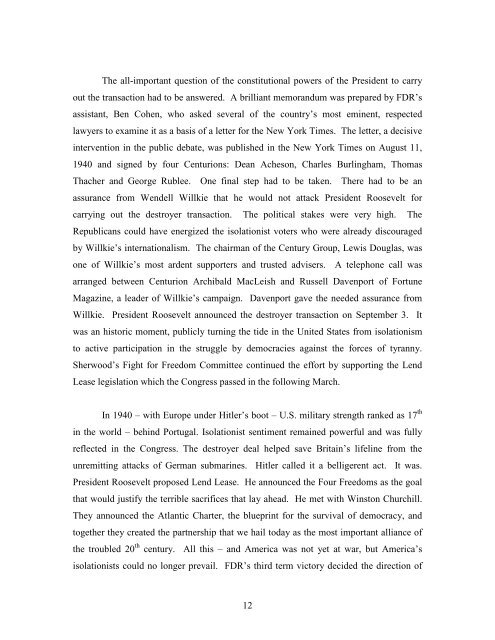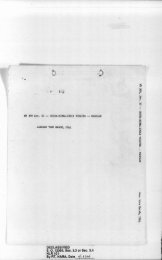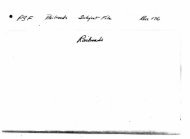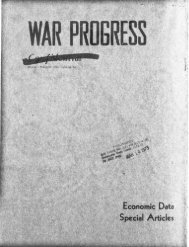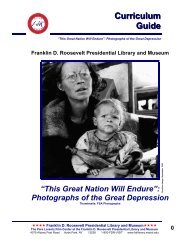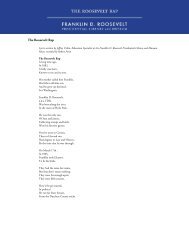Franklin Delano Roosevelt A Man of the Century
Franklin Delano Roosevelt A Man of the Century
Franklin Delano Roosevelt A Man of the Century
You also want an ePaper? Increase the reach of your titles
YUMPU automatically turns print PDFs into web optimized ePapers that Google loves.
The all-important question <strong>of</strong> <strong>the</strong> constitutional powers <strong>of</strong> <strong>the</strong> President to carry<br />
out <strong>the</strong> transaction had to be answered. A brilliant memorandum was prepared by FDR’s<br />
assistant, Ben Cohen, who asked several <strong>of</strong> <strong>the</strong> country’s most eminent, respected<br />
lawyers to examine it as a basis <strong>of</strong> a letter for <strong>the</strong> New York Times. The letter, a decisive<br />
intervention in <strong>the</strong> public debate, was published in <strong>the</strong> New York Times on August 11,<br />
1940 and signed by four Centurions: Dean Acheson, Charles Burlingham, Thomas<br />
Thacher and George Rublee. One final step had to be taken. There had to be an<br />
assurance from Wendell Willkie that he would not attack President <strong>Roosevelt</strong> for<br />
carrying out <strong>the</strong> destroyer transaction. The political stakes were very high. The<br />
Republicans could have energized <strong>the</strong> isolationist voters who were already discouraged<br />
by Willkie’s internationalism. The chairman <strong>of</strong> <strong>the</strong> <strong>Century</strong> Group, Lewis Douglas, was<br />
one <strong>of</strong> Willkie’s most ardent supporters and trusted advisers. A telephone call was<br />
arranged between Centurion Archibald MacLeish and Russell Davenport <strong>of</strong> Fortune<br />
Magazine, a leader <strong>of</strong> Willkie’s campaign. Davenport gave <strong>the</strong> needed assurance from<br />
Willkie. President <strong>Roosevelt</strong> announced <strong>the</strong> destroyer transaction on September 3. It<br />
was an historic moment, publicly turning <strong>the</strong> tide in <strong>the</strong> United States from isolationism<br />
to active participation in <strong>the</strong> struggle by democracies against <strong>the</strong> forces <strong>of</strong> tyranny.<br />
Sherwood’s Fight for Freedom Committee continued <strong>the</strong> effort by supporting <strong>the</strong> Lend<br />
Lease legislation which <strong>the</strong> Congress passed in <strong>the</strong> following March.<br />
In 1940 – with Europe under Hitler’s boot – U.S. military strength ranked as 17 th<br />
in <strong>the</strong> world – behind Portugal. Isolationist sentiment remained powerful and was fully<br />
reflected in <strong>the</strong> Congress. The destroyer deal helped save Britain’s lifeline from <strong>the</strong><br />
unremitting attacks <strong>of</strong> German submarines. Hitler called it a belligerent act. It was.<br />
President <strong>Roosevelt</strong> proposed Lend Lease. He announced <strong>the</strong> Four Freedoms as <strong>the</strong> goal<br />
that would justify <strong>the</strong> terrible sacrifices that lay ahead. He met with Winston Churchill.<br />
They announced <strong>the</strong> Atlantic Charter, <strong>the</strong> blueprint for <strong>the</strong> survival <strong>of</strong> democracy, and<br />
toge<strong>the</strong>r <strong>the</strong>y created <strong>the</strong> partnership that we hail today as <strong>the</strong> most important alliance <strong>of</strong><br />
<strong>the</strong> troubled 20 th century. All this – and America was not yet at war, but America’s<br />
isolationists could no longer prevail. FDR’s third term victory decided <strong>the</strong> direction <strong>of</strong><br />
12


